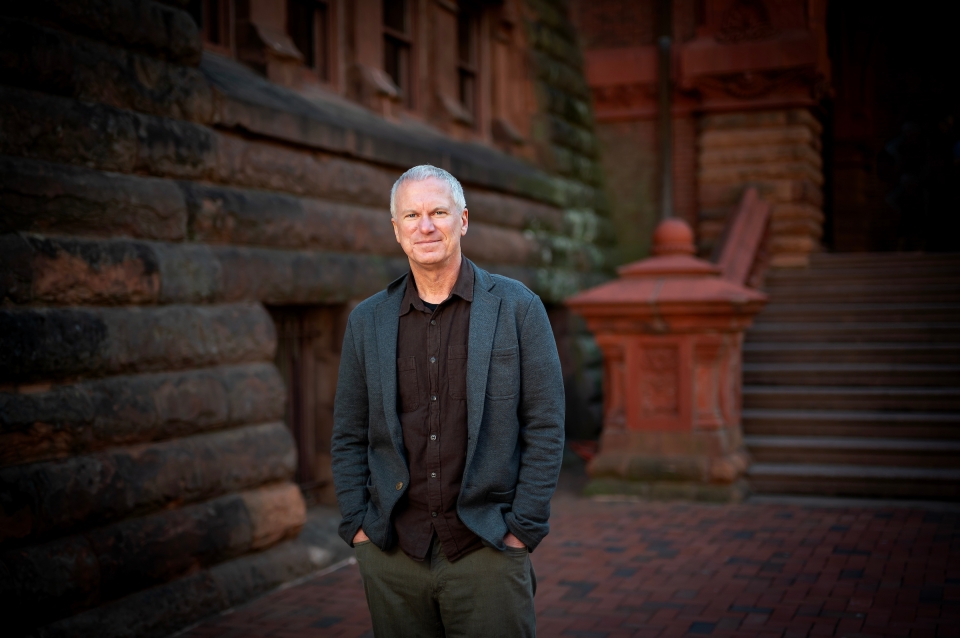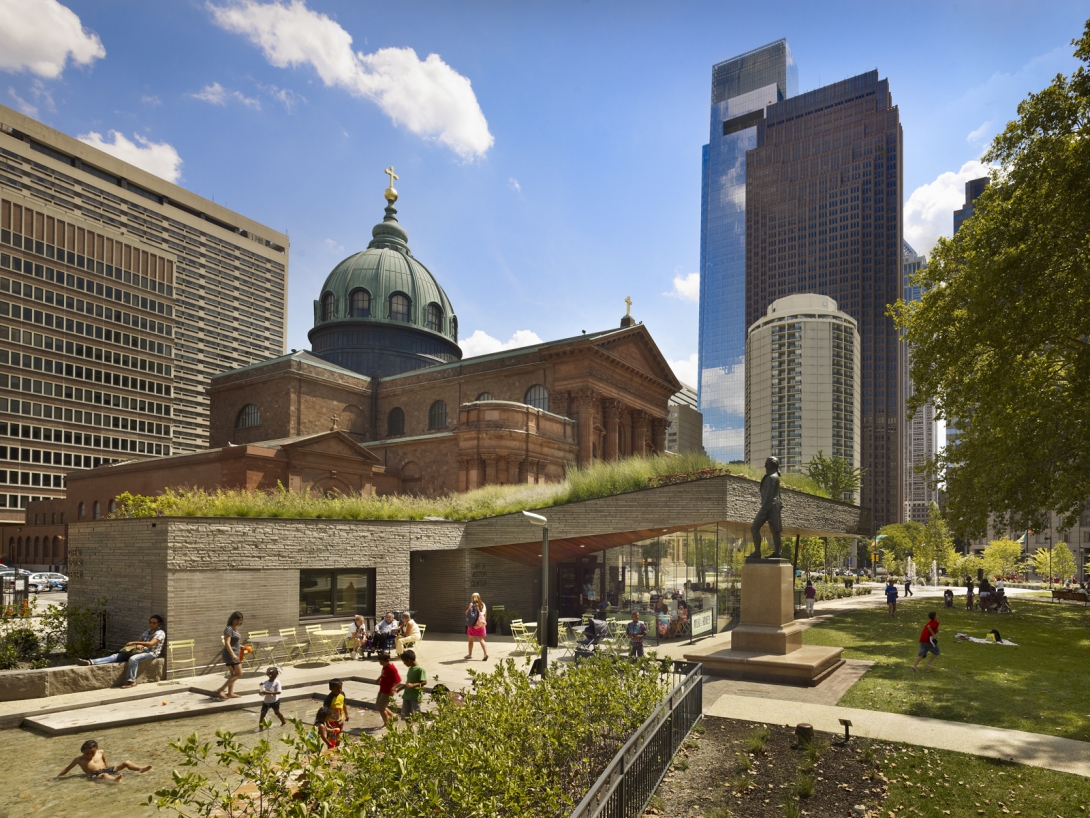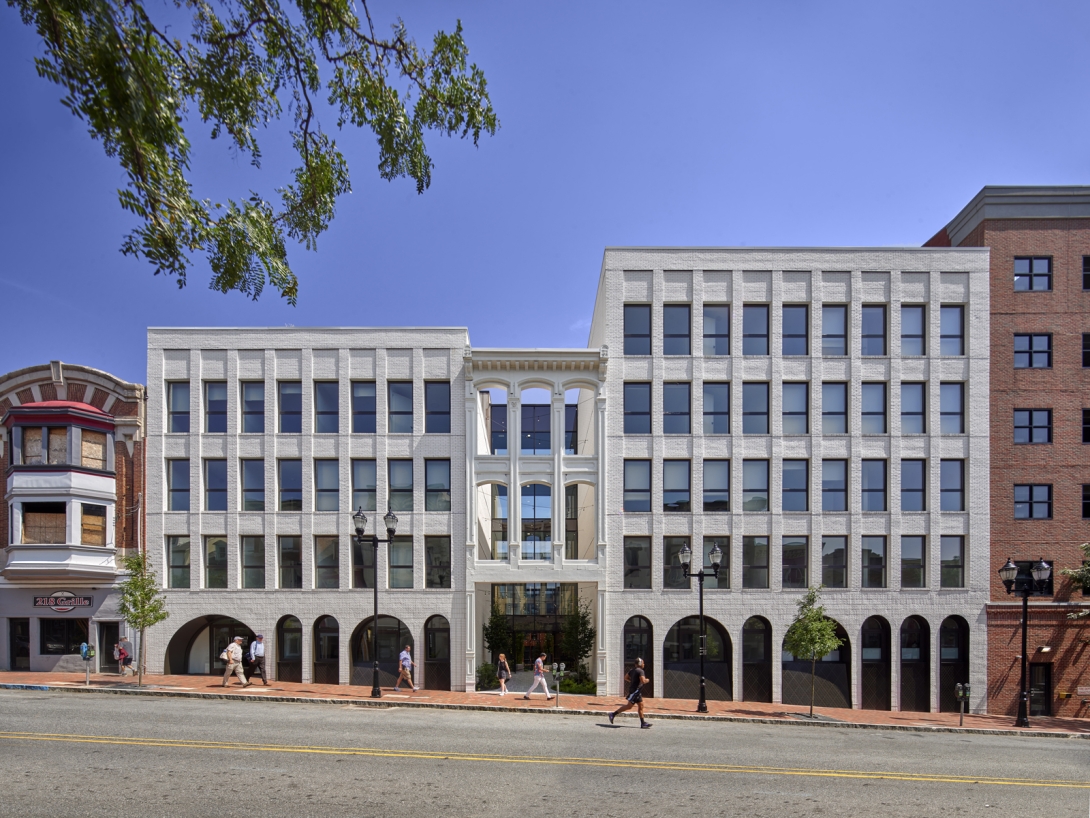January 8, 2025
Q&A: Jules Dingle, Professor of Practice in Historic Preservation
By Matt Shaw

Jules Dingle photographed outside Fisher Fine Arts Library in December of 2024 (Photo Eric Sucar)
Stuart Weitzman School of Design
102 Meyerson Hall
210 South 34th Street
Philadelphia, PA 19104

Jules Dingle photographed outside Fisher Fine Arts Library in December of 2024 (Photo Eric Sucar)
Michael Grant
mrgrant@design.upenn.edu
215.898.2539
Architect Jules Dingle joined the Weitzman faculty as professor of practice in the Department of Historic Preservation last fall. Dingle is a founding partner of DIGSAU, an award-winning interdisciplinary architecture and historic preservation practice in Philadelphia. In an interview, he describes DIGSAU’s approach to social and environmental sustainability, and how the Department of Historic Preservation provides an ideal environment in which to continue this research.
Could you talk a bit about your background and how you started DIGSAU?
I studied architecture at the University of Notre Dame and worked in private practice in Baltimore for a few years. After receiving my Master of Architecture at UC Berkeley in 2000, I moved to Philadelphia. I worked for a little over seven years at Kieran Timberlake (KT) where I met my three partners who would ultimately start DIGSAU with me in 2007. We were a young firm with no built work and no portfolio. This—coupled with the economic collapse of 2008—made it all the more difficult to convince people to hire us.
But by virtue of the need and the desire to do work here in Philadelphia, in those early years we were able to get a range of smaller jobs from kitchen renovations to projects with pretty cool mission-driven nonprofit organizations. Slowly, this led into work in higher education at colleges and universities like University of Delaware and Swarthmore College that took a chance on a young firm. For example, Paul Levy at Center City District commissioned us to do the Sister Cities pavilion on Logan Circle. This was a really big project for us as a young practice.
At DIGSAU, our work engages theory, but it's primarily shaped by future-oriented questions about cities and communities.
What would you say defines DIGSAU’s design ethos and process?
Open-mindedness. I think we're very much a firm that's been shaped by the work that we've taken on. Those early projects were formative to this open-minded approach to architecture, to who makes it, to how it's made, and to who benefits from it. We’ve never been fond of specialization (even though it'd probably be a good business decision to specialize a bit more than we do). We enjoy the breadth of work that we take on, including work for institutions, nonprofits, and commercial developers. Working across a range of client types and building types is an adventure.
If I were to point out one thing that binds our wide range of work, it would probably be: Good clients that recognize the value of design and open the door for us to amplify their mission through design. We think our strength is taking on the difficult problems—the ones that take a little more time, a little more creativity, a little more struggle.
People often ask about the name of the firm and what does DIGSAU mean. It’s technically an acronym of the four founders' last names, but it's more accurately just a new playful and meaningless word that can gather meaning and that can change with time. At the moment, DIGSAU refers to the 45 or so of us that work together here on North 12th Street and our clients, our work. I imagine it may mean something different in the future.

Sister Cities Café and Discovery Garden, Philadelphia (Halkin | Mason Photography)
How did you end up at Penn?
The preservation department has a very expansive view of what preservation means. It is not exclusively about physical material, but also about ecology, culture and who it serves. As I heard more from my friend [Adjunct Professor] David Hollenberg, who is also teaching at Weitzman, I began to think, “If that's what preservation is, then that's what DIGSAU does every day.”
At DIGSAU, our work engages theory, but it's primarily shaped by future-oriented questions about cities and communities. We pin things up on the wall and have theoretical discourse, but the architecture generates out of the assignment. For me, this new role at Weitzman has been a convergence of what DIGSAU does and the new territory that the preservation department is venturing into.
I was recently at a lecture in Meyerson Hall and a question being posited was whether the discipline of historic preservation needs to be torn down and rebuilt due to questions of equity, the environment, and technology, or if the discipline could be changed from within. I think the latter is more like what our department is doing. As the department thinks expansively about what preservation is, my colleagues at DIGSAU and I will think expansively about what our practice means.
You mentioned that much of what DIGSAU does is preservation work. Can you discuss a few projects?
One is a project in Los Angeles at the Watts Towers, a heritage site. We were asked to do a facilities assessment and to provide a long-term vision for the structures there, specifically the Watts Towers Arts Center, the Charles Mingus Gallery, and a few educational facilities accompanying the towers themselves. The history of Watts Towers and the deep significance they have to the community tie to the question we’ll ask in the capstone studio, “How can an important heritage site can be a catalyst for community self-determination?”
Rebuild Philadelphia is a larger project. It is a city initiative that allocates tax money to improving libraries and recreation centers. The first project is the Francis J. Myers Recreation Center (FJMRC) in West Philly and the second is the Carousel House in the Centennial District. They are both fantastic community anchors, in totally different neighborhoods. In both cases, our work asks many architecture and design questions that are fundamentally about preserving communities. Many of these neighborhoods are woefully underserved in terms of recreation, community space, and the amenities that are essential for a community to be a community.
In the case of FJMRC, for example, there is a half century of deferred maintenance and inaccessible existing conditions. Each project aspires to LEED gold or silver and aims to be very sustainable. But looking at the recreation centers in the context of the neighborhoods they support, the real sustainability questions have very little to do with energy performance. The goal is to make a neighborhood viable, stronger, as well as to promote the model of urban life that we think the planet needs. You could triple the energy use intensity in one of those buildings and it would still be an incredibly sustainable asset because of the degree to which it preserves and sustains a dense urban community.
On that note, tell me more about what you’ll be working on in the department.
I’ll be leading the master’s in historic preservation design track. With this, I think there is an opportunity to teach design studios in a different way. I think I’ve heard [Gonick Family Professor] Frank Matero, our chair, say that, historically, preservation was an academic department in a design school. Using this as a starting point, there’s an opportunity to do something interdisciplinary, something a bit more collaborative. Something that might cross boundaries that weren’t crossed when I was an architecture student or even when I’ve taught architecture studios previously. I think the real opportunity we have is not only to be the capstone for preservation students who are interested in design, but also to bring in landscape architects, architecture students, city planners, MFAs, and anybody in the Weitzman School—possibly even beyond—who want a broader, interdisciplinary, and slightly more empirically-based studio experience.

The Cooper, Wilmington, Delaware (Halkin | Mason Photography)
How are the concerns of historic preservation changing today?
I’ll preface this by saying I wouldn’t really consider myself a historic preservation expert, at least in the conventional sense, so I may not fully be articulating what preservation has been historically. That said, I think that preservation is opening up to be less object-focused than it traditionally has been. We are asking ourselves deeper questions about what is worthy of preserving and who will it serve. Sometimes this involves preserving physical artifacts and sometimes this involves an idea or cultural concept. Sometimes these overlap and sometimes they don’t. For me at least, this is a radical departure from how I understood historical preservation practice.
Are any of the techniques of historic preservation particularly exciting to you, as a designer?
Yes, and this this something I’m just getting to know since the breadth of our department is so impressive. At one end is the conservation side—one that is much more of a scientific discipline involving students in labs doing things that I couldn’t tell you I fully understand, but are really impressive. On the other end is preservation planning and design. While we do conservation as part of our work, conservation is mostly about continuity. What excites me more is the intersection of preservation and change, and how, in many ways, the key to preserving something is changing it. As architects in a contemporary practice, we garner energy from change, from the need for things to evolve, and for history not to be seen as a distinct moment in time but rather as part of a continuum. As preservationists, there is an open-mindedness to change that excites us.
How are you incorporating this line of thinking into the program? How does it influence the role that preservation could play in creating more equitable and sustainable places?
I’ll tell you about where I think the capstone studio at Weitzman this spring is headed. We’re going to try something new. Typically, in the preservation department, there’s been the option to either do a thesis, write a 100-page paper, or do a capstone studio, which has varied from year to year but was often more studio-based than thesis-based. This sometimes meant that people were working on a defined problem and not necessarily pursuing an area of their own personal interest.
I think that preservation is opening up to be less object-focused than it traditionally has been. We are asking ourselves deeper questions about what is worthy of preserving and who will it serve.
What we have in mind is something that will be more like a mini thesis. We’re going to be working on an urban city block—most likely a block in Strawberry Mansion that’s bisected by the diagonal of Ridge Avenue. It includes the [Henry Ossawa] Tanner House, which is an important heritage site. We’re going to work as a group and students will bring in their own background and interests, which are very wide-ranging. Before they come to our program, people come from anywhere—from history to architecture to engineering. Their interests may be about preserving or about conserving elements of historic structures. They may be interested in storytelling or public history. They may be interested in urban landscape or commercial corridors. They could be interested in affordable housing and how infill housing allows communities to stay together through aging in place, or other models suited to current neighborhood residents.
Strawberry Mansion is a neighborhood that’s changed radically over the last several hundred years and it continues to change. Gentrification, issues of the environment, transportation, economics, and technology are all forces acting on the neighborhood. [For this mini thesis], everybody will be pursuing a question of their own particular interest starting with that city block. However, what will bind all those pursuits will be the overarching question, “How can a heritage site (the Tanner House and Strawberry Mansion itself) be a catalyst for a community’s self-determination?” The project aims to get at the question of what it means to preserve in a neighborhood like this. It also asks how the community would have a voice in shaping what is preserved, how it’s preserved, and who that would serve. These are large questions that won’t be answered exclusively by students or the abridged community engagement of a single semester, so the work will aim to provide creativity and tools to foster a next level of planning and design inquiry within the community. The power of the work will be that it is left unfinished.
With this pursuit, I hope we will be proving that heritage preservation can truly serve questions of economic and social equity, and that this begins with us thinking more broadly about the discipline of preservation itself.